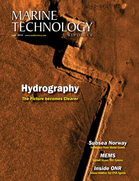Sonardyne System to Monitor North Sea CO2 Leaks
Posted by Irina Tabakina
Sonardyne International is taking part in a new Energy Technologies Institute (ETI) project within the Carbon Capture Storage (CCS) program to develop a Carbon Dioxide (CO2) marine and shallow subsurface monitoring system for underground CCS sites in the North Sea. The system will monitor for any CO2 leakage from saline aquifers and offshore storage sites such as oil and gas fields, both active and depleted.
The development of a U.K.-based North Sea CCS industry is an important element in the government’s initiative to significantly cut greenhouse gas emissions by 2050, mitigating against high future energy costs and for developing high value, low carbon industries. Other members of the Consortium are lead participant Fugro GEOS Ltd., the National Environment Research Council (NERC – as represented by the National Oceanography Centre and British Geological Society), Plymouth Marine Laboratory and the University of Southampton.
Using technologies already proven in the offshore and oceanographic industries, combined with new remote sensing technology, the consortium will develop an integrated leak detection system that is capable of both wide area coverage by AUVs/ASVs (Autonomous Underwater Vehicles/Autonomous Surface vehicles) and continuous automated monitoring of high risk areas. For these sites, the use of Sonardyne’s Automatic Leak Detection Sonar (ALDS) has been proposed. ALDS is both an active and passive sonar capable of monitoring more than one billion cubic feet of water for the smallest of leaks. The system is fully automated, offering reliable detection, rapid notification and localization of leaks. It provides continuous 360° coverage, detecting leaks after only tens of seconds.
As the data is gathered from both ALDS, the AUVs/ASVs and other monitoring technologies, it will be relayed to shore using a combination of wireless acoustic and satellite communications and existing reservoir infrastructure acting as surface-to-shore relay stations. Sonardyne’s Autonomous Monitoring Transponders (AMTs) will form the core power, data logging and communications backbone for this data sensing and relay. AMT’s autonomously acquire acoustic ranges and sensor data is then time-stamped and logged internally for recovery via the integrated high-speed acoustic telemetry modem. This autonomy allows measurements to be made over long periods of time and a wide range of sensors for the detection of CO2 can be interfaced and integrated, providing an ultra-low power platform for up to five years unattended deployment.
www.sonardyne.com
(As published in the June 2014 edition of Marine Technology Reporter - http://www.marinetechnologynews.com/Magazine)

 December 2025
December 2025



